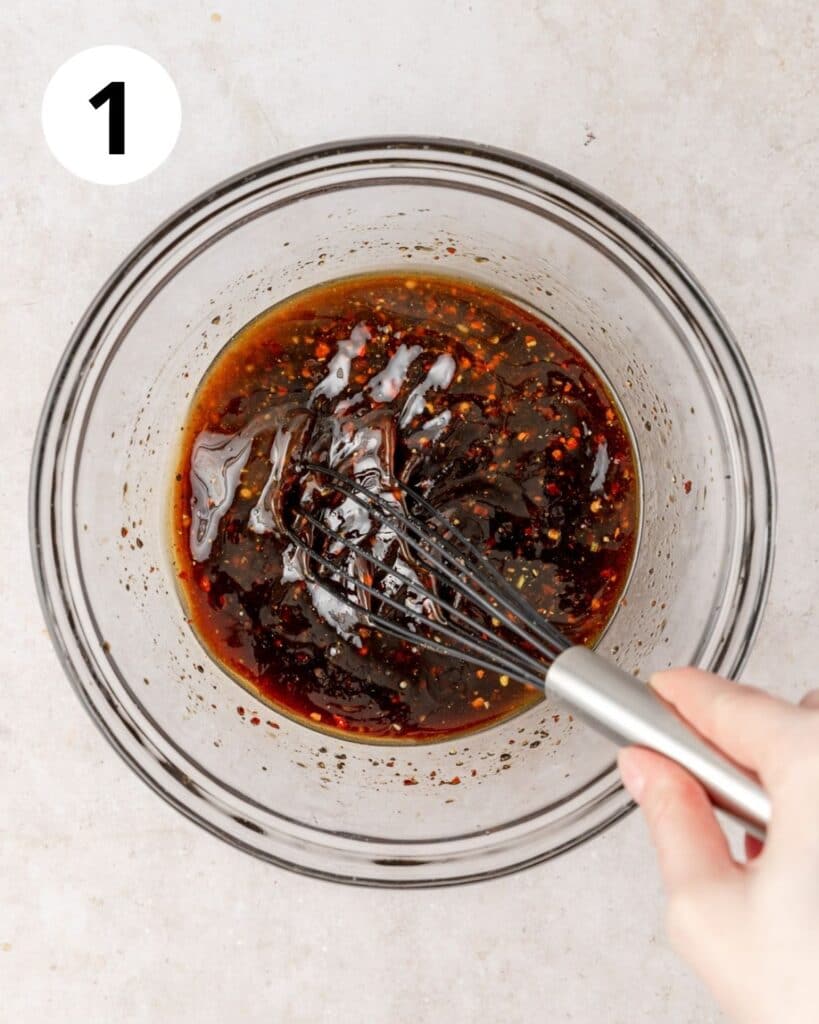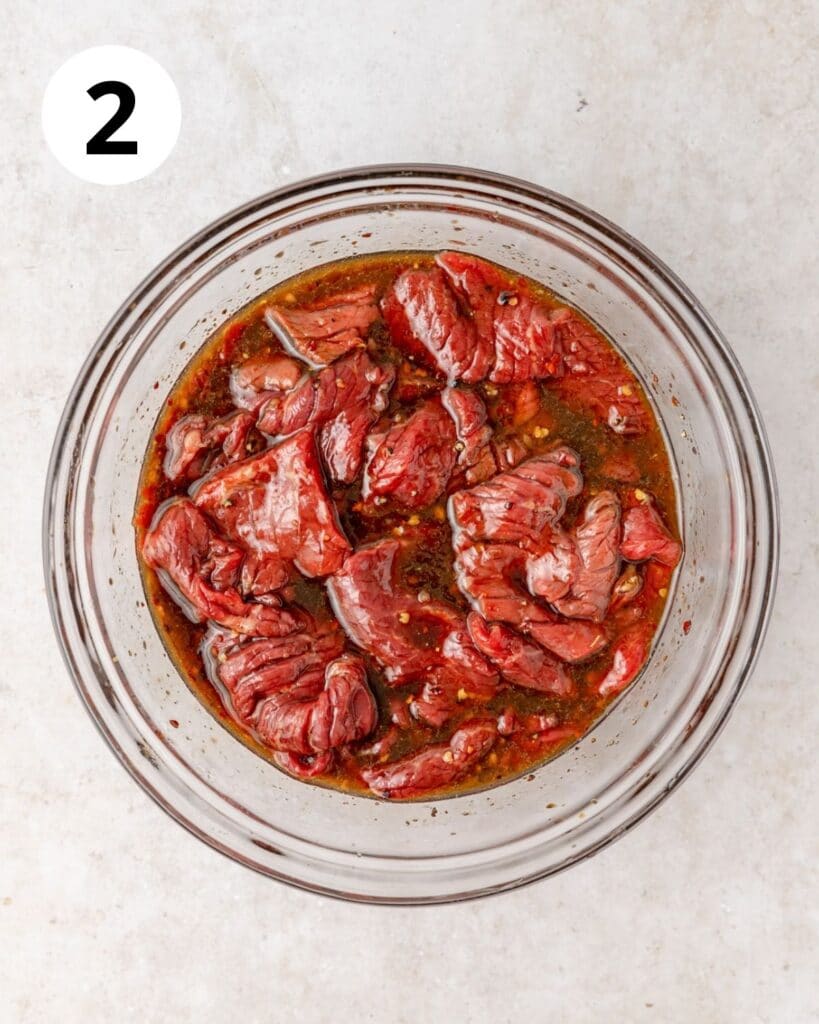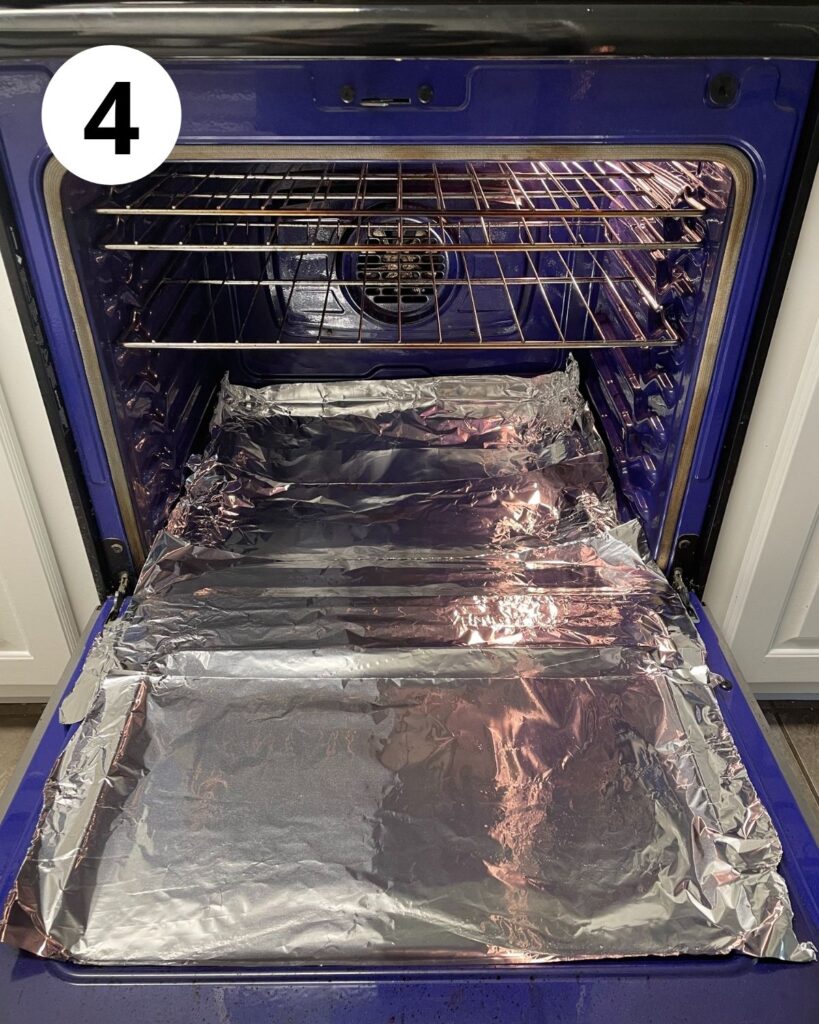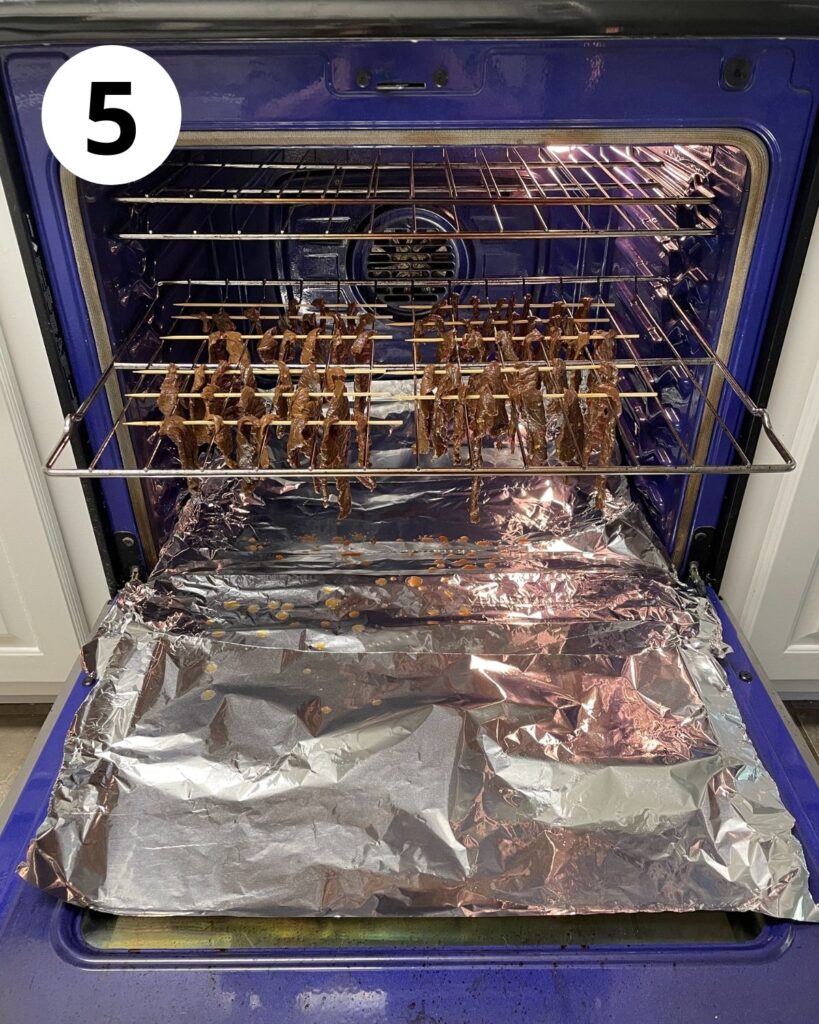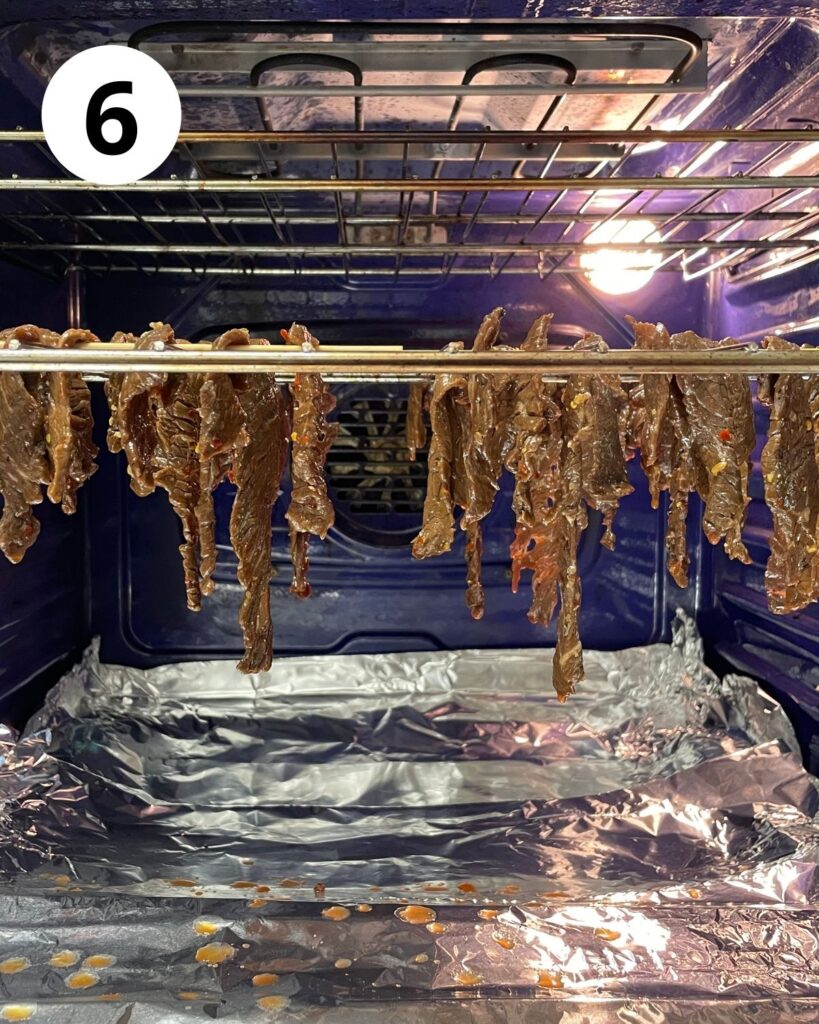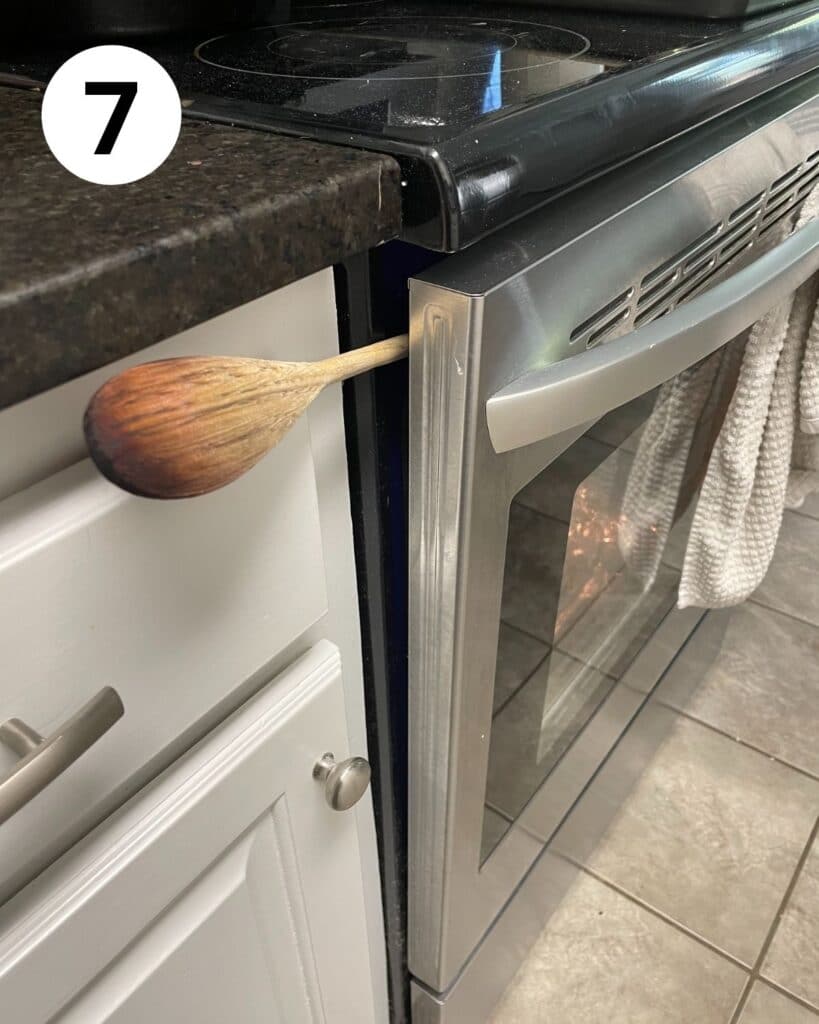How to Make Beef Jerky With Flank Steak

There's nothing I love more than homemade beef jerky but I don't own a dehydrator. Luckily, making beef jerky in the oven is surprisingly easy! [Don't get me wrong, a dehydrator is definitely easier but most people don't own one.]
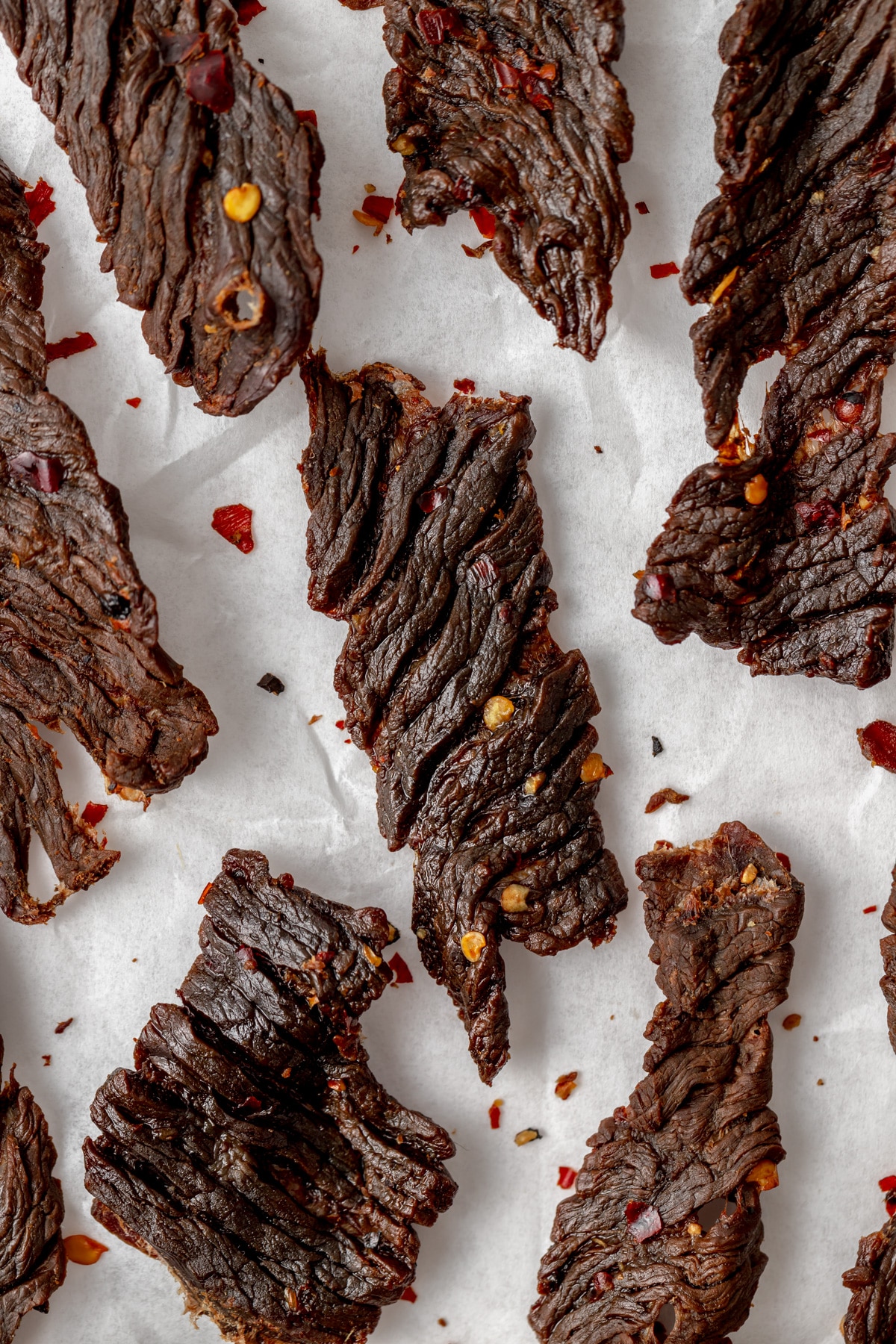
Homemade beef jerky is a great snack for camping, a lunchbox, or game-day!
Ingredient Notes
To make homemade beef jerky you really just need meat and then your favorite flavorful marinade!
What type of meat is best for jerky?
Almost any lean cut of meat will work well for jerky! You don't want to use a cut with a lot of fat as the fat doesn't render while dehydrating. My favorite is a top round (also called london broil) but there are several popular options!
- Top round (london broil)
- Flank steak
- Skirt steak
- Bottom round
- Sirloin tip
How to cut meat for jerky?
You want to slice the meat somewhere between ⅛" and ¼" thick. The thinner the slices, the dryer and less chewy the jerky will be. But the thicker it is, the longer it takes to fully dry.
For chewy jerky - slice along the grain.
For more tender jerky - slice against the grain.
Also be sure to trim away any large chunks of fat.
Pink Curing Salt
This is optional, but highly recommended! Curing salt (also called Cure #1 or pink salt) contains a small amount of sodium nitrite. This helps prevent bacteria growth and also improves the color of the jerky!

The best beef jerky marinade!
You can use whatever marinade you prefer, but I just love this simple soy based marinade! It's savory, aromatic, and just a tad spicy!
You need:
- Soy sauce
- Olive oil
- Liquid smoke - this adds the perfect slightly smoky flavor to the jerky!
- Lime juice - you could also use lemon juice or orange juice!
- Honey - substitute maple syrup or brown sugar.
- Red pepper flakes - omit if you prefer a less spicy beef jerky.
- Garlic
- Ginger
How to Make Jerky That's Safe to Consume
Adding the pink curing salt to the marinade is one way to help ensure the jerky is safe to eat!
The other method is to bring the meat up to 160°F before dehydrating (source: USDA). So to do this we'll roast the meat at 300°F for 10 minutes before we start trying to dehydrate it.
It's also important to marinate the beef strips in the fridge and not leave them at room temperature for any extended period of time!
How to make Beef Jerky in the Oven
Thinly slice the meat between ⅛" and ¼" thick.
In a medium sized bowl, whisk together all the marinade ingredients until fully combined.
Add in the meat slices and toss to coat.
Cover and refrigerate for 24 to 48 hours! Marinating the meat for a long time makes the jerky SO flavorful and helps tenderize tougher cuts of beef.
Discard the marinade and gently pat the slices of beef dry. Skewer the meat so that it hangs straight down, with at least 1 inch between each piece. This will allow the air to fully circulate around the meat so that it dries more quickly.

Line the bottom of your oven with aluminum foil (do NOT skip this unless you want to be scrubbing burnt marinade off the bottom of your oven for the rest of time).
Preheat the oven to 300°F
Place the skewers across the oven racks so that the strips hang down.
Bake the meat for 10 minutes at 300°F.
Then turn your oven down to the lowest temperature it can go (most home ovens go down to about 170°F). Typically beef jerky is dehydrated between 140°F and 150°F and there is some type of air circulation. So to achieve similar results with your home oven, crack the door open and use a wooden spoon to hold the door open in that position.
Continue to dry the jerky for 4 to 8 hours depending on the thickness of the jerky. The jerky is done when it's completely dry but is still somewhat pliable and bends without breaking.
After about 2 hours I like to check the jerky every 30 minutes observe the progress. Depending on your oven, the back by dry more quickly than the front, so it's okay to begin removing some pieces before the rest are dry!
Once the beef jerky is fully dry, let cool to room temperature before storing.
For best results and the longest shelf life, vacuum seal the jerky for storing! I love my Zwilling Fresh and Save Set for storing this beef jerky!

Recipe FAQ's
How long does homemade beef jerky last?
If stored in a vacuum sealed bag, homemade jerky will last at room temperature for up to a month. But if stored in a regular ziploc bag, it's best consumed within 1 to 2 weeks. Always store in a cool, dry, dark place!
Is it cheaper to make beef jerky at home?
Typically yes! Depending on which cut of beef you use, homemade jerky can be significantly cheaper than store-bought.
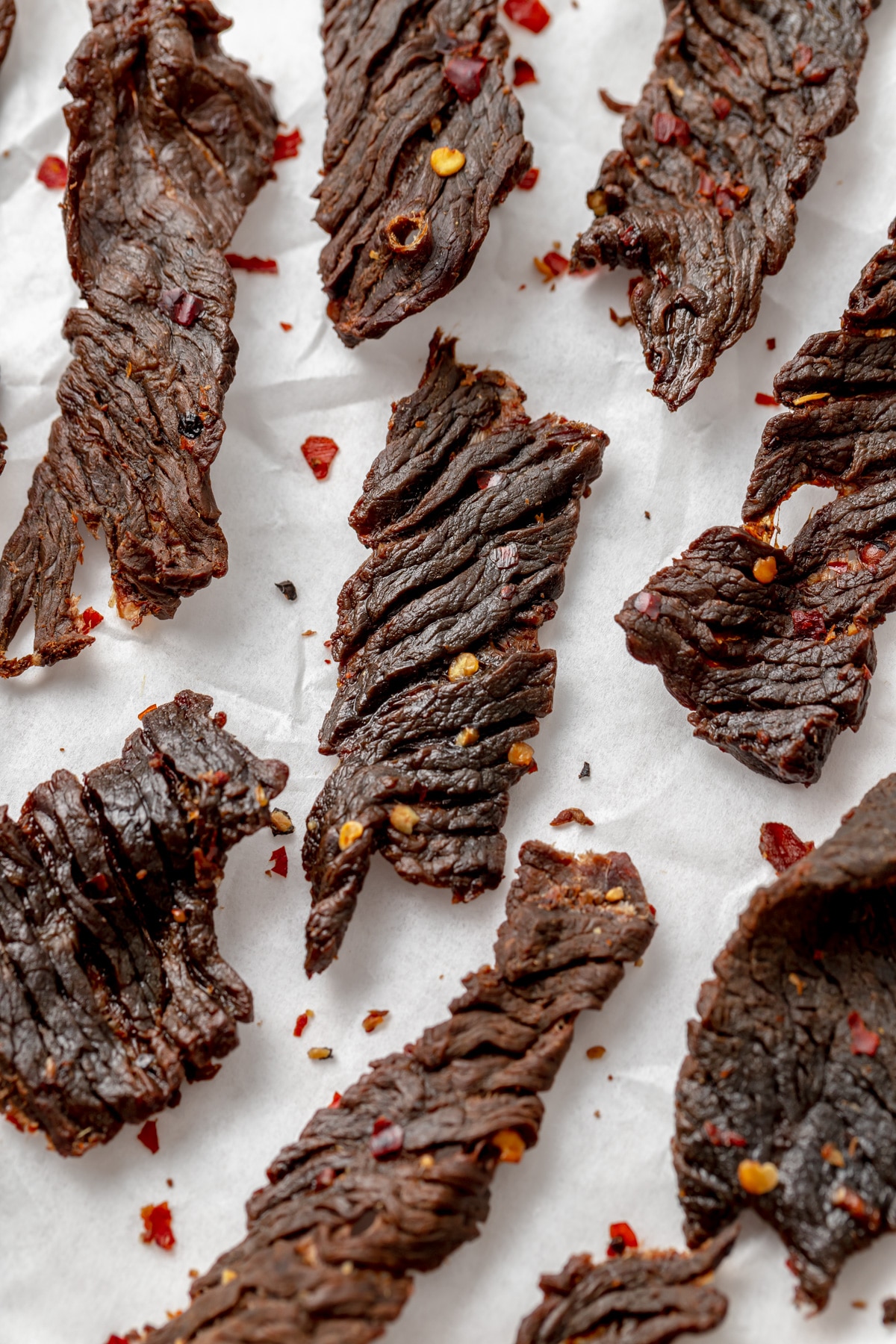
More Recipes You Might Like
-
Sourdough Soft Pretzels with Homemade Beer Cheese
-
Salted Caramel Popcorn
-
How to Dry Orange Slices in the Oven
-
Cheesy Sourdough Discard Crackers
If you make this recipe, please leave a star rating at the bottom of the page! This provides helpful feedback to both me and other readers. And if you want more delicious, scratch-made recipes you can subscribe to my newsletter and follow along on Instagram, Pinterest, and Facebook!

-
aluminum foil
-
skewers
- 2 pounds top round, london broil, or flank steak
- 1 cup soy sauce
- ¼ cup olive oil
- ¼ cup lime juice
- 2 tablespoons honey , substitute brown sugar or maple syrup
- 1 teaspoon liquid smoke
- 2 teaspoons minced garlic , substitute garlic powder
- 1 teaspoon minced ginger , substitute ground ginger
- 2 teaspoons red pepper flakes
- 1 teaspoon ground black pepper
- ½ teaspoon pink curing salt , optional
-
Thinly slice the meat between ⅛" and ¼" thick.
-
In a medium sized bowl, whisk together all the marinade ingredients until fully combined.
-
Add in the meat slices and toss to coat.
-
Cover and refrigerate for 24 to 48 hours! Marinating the meat for a long time makes the jerky SO flavorful and helps tenderize tougher cuts of beef.
-
Discard the marinade and gently pat the slices of beef dry. Skewer the meat so that it hangs straight down, with at least 1 inch between each piece. This will allow the air to fully circulate around the meat so that it dries more quickly.
-
Line the bottom of your oven with aluminum foil (do NOT skip this unless you want to be scrubbing burnt marinade off the bottom of your oven for the rest of time).
-
Preheat the oven to 300°F
-
Place the skewers across the oven racks so that the strips hang down.
-
Bake the meat for 10 minutes at 300°F.
-
Then turn your oven down to the lowest temperature it can go (most home ovens go down to about 170°F). Typically beef jerky is dehydrated between 140°F and 150°F and there is some type of air circulation. So to achieve similar results with your home oven, crack the door open and use a wooden spoon to hold the door open in that position.
-
Continue to dry the jerky for 4 to 8 hours depending on the thickness of the jerky. The jerky is done when it's completely dry but is still somewhat pliable and bends without breaking.
-
After about 2 hours I like to check the jerky every 30 minutes observe the progress. Depending on your oven, the back by dry more quickly than the front, so it's okay to begin removing some pieces before the rest are dry!
-
Once the beef jerky is fully dry, let cool to room temperature before storing.
-
For best results and the longest shelf life, vacuum seal the jerky for storing! I love my Zwilling Fresh and Save Set for storing this beef jerky!
If stored in a vacuum sealed bag, homemade jerky will last at room temperature for up to a month. But if stored in a regular ziploc bag, it's best consumed within 1 to 2 weeks. Always store in a cool, dry, dark place!
See full blog post for tips on how to safely make and consume homemade beef jerky. Consuming raw or undercooked meat always carries some risk of foodborne illness. Consume at your own risk.
Serving: 1 | Sodium: 2173 mg | Calcium: 13 mg | Vitamin C: 3 mg | Vitamin A: 205 IU | Sugar: 7 g | Fiber: 1 g | Potassium: 115 mg | Calories: 129 kcal | Monounsaturated Fat: 7 g | Polyunsaturated Fat: 1 g | Saturated Fat: 1 g | Fat: 9 g | Protein: 4 g | Carbohydrates: 9 g | Iron: 1 mg
The nutritional information on this website is only an estimate and is provided for convenience and as a courtesy only. The accuracy of the nutritional information for any recipe on this site is not guaranteed.
vonstieglitzforrinfort.blogspot.com
Source: https://www.barleyandsage.com/homemade-beef-jerky-in-the-oven/
